Sivaganga
Sivaganga (Tamil: [siʋaɡəŋɡaɪ])Sivaganga district in the South Indian state of Tamil Nadu. It is also the headquarters of the Sivaganga District. The town is located at a distance of 48 km (30 mi) from Madurai and 449 km (279 mi) from the state capital Chennai. It is an important town in this district for official and commercial purposes. Its nickname was Sivaganga Seemai .
Sivaganga | |
|---|---|
Municipality | |
Sivagangai Entrance Arch | |
| Nickname(s): Sivagangai Seemai | |
 Sivaganga Location in Tamil Nadu, India | |
| Coordinates: 9.87°N 78.48°E | |
| Country | |
| State | Tamil Nadu |
| District | Sivagangai |
| Region | Pandya Nadu |
| Division | Madurai |
| Government | |
| • Type | selection Grade Municipality |
| • Body | Sivagangai Municipality |
| • Chairperson | Mr M.Arujunan B.A.[1] |
| • Vice Chairperson | Mr V.Sekar.[2] |
| • Commissioner of Municipality | Mr R.Subramanian B.COM.[3] |
| Area | |
| • Total | 10.2 km2 (3.9 sq mi) |
| Elevation | 102 m (335 ft) |
| Population (2011) | |
| • Total | 92,359 |
| • Density | 11,588/km2 (30,010/sq mi) |
| Languages | |
| • Official | Tamil |
| Time zone | UTC+5:30 (IST) |
| PIN | 630561,630562 |
| Telephone code | 04575 |
| Vehicle registration | TN-63 |
| Distance from Madurai | 40 kilometres (25 mi) WEST (Road) |
| Distance from Trichirapalli | 130 kilometres (81 mi) NORTH (Rail) |
| Distance from Rameswaram | 120 kilometres (75 mi) SOUTH (Rail) |
| Website | www |
Sivaganga kingdom was founded by Sasivarna Periya Oodaya Thevar in 1730. The town was subsequently ruled by his successors and ultimately by Velu Nachiyar under the stewardship of Maruthu Pandiyar. They were against the British Empire, but ultimately lost to them in 1790. The Company appointed Gowry Vallaba Periya Oodaya Thevar as the Zamindar of Sivaganga in 1801, whose successors continued with chaos until India's independence in 1947. It was under Ramnad district until 1984 and subsequently a part of the newly formed Sivaganga district. The town is known for agriculture, metal working and weaving. The region around Sivaganga has considerable mineral deposits.
Sivaganga is administered by a municipality established in 1965. As of 2011, the municipality covered an area of 7.97 km2 (3.08 sq mi) and had a population of 92,359 Sivaganga comes under the Sivaganga assembly constituency which elects a member to the Tamil Nadu Legislative Assembly once every five years and it is a part of the Sivaganga constituency which elects its Member of Parliament (MP) once in five years. Roadways are the major mode of transportation to the town and it also has rail connectivity. The nearest seaport, V. O. Chidambaranar Port Trust, Thoothukudi is located 189 km (117 mi) from Sivaganga, while the nearest airport, Madurai International Airport, is located 53 km (33 mi) from the town.
History
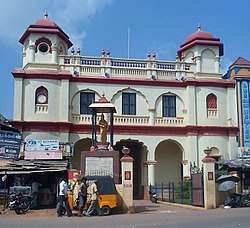
During the 17th century, Sivaganga was ruled by the Kingdom of Ramnad, which had its boundary spreading across modern-day Sivaganga, Pudukkottai and Ramnathapuram. The seventh king of the empire, Vijaya Raghunatha Sethupathi (also called Kelvan Sethupathy) ruled from 1674 to 1710 and was succeeded by his sister's son Vijia Regunatha Sethupathy. He was succeeded by his son-in-law Sundareswara Regunatha Sethupathy in 1726. Bavani Sankara Thevan, the illegitimate son of Regunatha Sethupathy aligned with the Rajah of Tanjore to attack Ramnad. Though Bavani won, he did not honour the earlier decision to cede some portions of the empire to the King of Tanjore. He quarrelled with Sasivarna Periya Oodaya Thevar and sent him out of his province. Both Sasivarna and Kattaya Thevar, the brother of Sundareswara, aligned with the Rajah of Tanjore. Both of them conquered Bavani in 1730 with the help of the army of Tanjore. Kattaya Thevar divided the kingdom into five provinces and gave two to Sasivarna, who became the first king of Sivaganga. As per legend, Sasivarna built the Teppakulam and fort around the spring "Sivaganga", where he met his spiritual guru Sathappier. As per another account, Sasivarna was appointed as the king by the Nawab of Carnatic.[4] Sasivarna died at around 1750 and his son Muthuvaduganatha Periya Udaya Thevar took over the reign. He was shot dead in 1780 by Nawab's troops. His widow Velu Nachiyar and infant Vellacci fled the region and were aided by the two Maruthu brothers namely Periya Maruthu and Chinna Maruthu. Velu Nachiyar ruled the region till 1790, when her daughter succeeded her. The brothers still continued the support the new queen. The brothers rebelled against the British East India Company and Nawab of Carnatic, who was supporting the company. The brothers were later captured and hanged in Tirupathoor. The Company appointed Gowry Vallaba Periya Oodaya Thevar as the Zamindar of Sivaganga in 1801.[5]
Geography
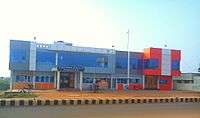
Sivaganga has an average elevation of 102 metres (334 feet).The town has a tropical wet and dry climate. The maximum temperature during summer is 39 °C and during winter it is 28 °C. The minimum temperature varies from 24.5 °C to 26.0 °C. The seasonal climate conditions are moderate and the weather is uniformly salubrious. The town gets major rainfall during the north east monsoon period. The Annual normal rainfall varies from 336.2 mm. The average annual rainfall being received in the town is 931 mm.[6]
| Climate data for Sivaganga | |||||||||||||
|---|---|---|---|---|---|---|---|---|---|---|---|---|---|
| Month | Jan | Feb | Mar | Apr | May | Jun | Jul | Aug | Sep | Oct | Nov | Dec | Year |
| Average high °C (°F) | 28.6 (83.5) |
30.3 (86.5) |
32.1 (89.8) |
35.8 (96.4) |
37.0 (98.6) |
37.0 (98.6) |
34.9 (94.8) |
33.6 (92.5) |
33.5 (92.3) |
31.7 (89.1) |
30.1 (86.2) |
28.5 (83.3) |
32.8 (91.0) |
| Average low °C (°F) | 23.9 (75.0) |
23.8 (74.8) |
24.8 (76.6) |
27.1 (80.8) |
27.8 (82.0) |
27.3 (81.1) |
26.7 (80.1) |
26.3 (79.3) |
26.0 (78.8) |
25.5 (77.9) |
24.7 (76.5) |
24.1 (75.4) |
25.7 (78.2) |
| Average precipitation mm (inches) | 30.4 (1.20) |
11.5 (0.45) |
18.1 (0.71) |
49.2 (1.94) |
75.1 (2.96) |
47.9 (1.89) |
64.2 (2.53) |
73.4 (2.89) |
91.7 (3.61) |
181.6 (7.15) |
196.5 (7.74) |
91.9 (3.62) |
931.5 (36.69) |
| Source: Climate Sivaganga | |||||||||||||
Demographics
| Year | Pop. | ±% |
|---|---|---|
| 1961 | 15,642 | — |
| 1971 | 20,826 | +33.1% |
| 1981 | 24,832 | +19.2% |
| 1991 | 33,190 | +33.7% |
| 2001 | 40,220 | +21.2% |
| 2011 | 92,359 | +129.6% |
| Sources: | ||
According to 2011 census, Sivaganga had a population of 40,403 with a sex-ratio of 990 females for every 1,000 males, much above the national average of 929.[8] A total of 3,880 were under the age of six, constituting 1,985 males and 1,895 females. Scheduled Castes and Scheduled Tribes accounted for 9.59% and 0.07% of the population respectively. The average literacy of the town was 83.86%, compared to the national average of 72.99%.[8] The town had a total of 10,184 households. There were a total of 14,145 workers, comprising 164 cultivators, 294 main agricultural labourers, 246 in house hold industries, 11,406 other workers, 2,035 marginal workers, 54 marginal cultivators, 127 marginal agricultural labourers, 173 marginal workers in household industries and 1,681 other marginal workers.[9] Sivaganga town had a growth of 25% during the decades of 1991 and 2001. The population density of the town has nearly doubled in the decades of 1981, 1991 and 2001. Spread over area of 6.970 km2 (697.0 ha), the density increased from 3500 person per km2 in 1981 and to 4,800 person per km2 in 1991. The development was largely concentrated along the whole town area.[10]
As per the religious census of 2011, Sivaganga had 84.75% Hindus, 10.07% Muslims, 4.66% Christians, 0.02% Sikhs, 0.01% Buddhists and 0.49% following other religions.[11]
Administration
Sivaganga is the district headquarters of Sivaganga District. It is bounded by Pudukkottai district on the Northeast, Tiruchirapalli district on the North, Ramanathapuram district on South East, Virudhunagar district on South West and Madurai District on the West.[12] Sivaganga District was carved out from composite Ramnad District during July 1984. Sivaganga is the headquarters of Sivagangai Block, which has43 Panchayat Villages. Sivagangai Taluk is the largest Taluk in Sivagangai District having 130 Revenue villages. The District Courts of Sivaganga is present in the town. These courts are under administrative and judicial control of the Madras High Court (Madurai Bench) of the State.[13]
| Municipality Officials | |
|---|---|
| Chairman | M. Arujunan[14] |
| Commissioner | K. Saravanan[15] |
| Vice Chairman | V. Sekar[16] |
| Elected Members | |
| Member of Legislative Assembly | Cholan CT. Palanichamy[17] |
| Member of Parliament | Karti P. Chidambaram[18] |
The municipality of Sivaganga was constituted as a third grade municipality in 1965 and promoted to first grade during May 1998.[19] As of 2008, the municipality covered an area of 6.97 km2 (2.69 sq mi) and had a total of 27 members. The functions of the municipality is devolved into six departments: General, Engineering, Revenue, Public Health, Town planning and the Computer Wing. All these departments are under the control of a Municipal Commissioner who is the supreme executive head.[20] The legislative powers are vested in a body of 27 members, one each from the 27 wards. The legislative body is headed by an elected Chairperson assisted by a Deputy Chairperson.[21] The municipality had an income of ₹54,631,000 and an expenditure of ₹75,385,000 for the year 2010–11.[22]
Sivaganga comes under the Sivaganga State Assembly Constituency and it elects a member to the Tamil Nadu Legislative Assembly once every five years.[23][24] From the 1977 elections, the assembly seat was won by Dravida Munnetra Kazhagam (DMK) twice during the 1989 and 1996 elections, the Communist Party of India once during the 2006 elections, Indian National Congress three times during 1977, 1980 and 1984 elections, and the All India Anna Dravida Munnetra Kazhagam (AIADMK) three times during the 1991, 2001 and 2011 elections.[25] The current Member of Legislative Assembly (MLA) of the constituency is Cholan CT. Palanichamy from the AIADMK Party.[17]
Sivaganga is a part of the Sivaganga (Lok Sabha constituency) – it has the following six assembly constituencies – Thirumayam, Tiruppattur, Karaikudi, Alangudi, Manamadurai and Sivaganga. From 1967, the Sivanganga parliament seat was held by the Indian National Congress for nine times during 1980,[26] 1984,[27] 1989,[28] 1991,[29] 1999,[30] 2004,[31] 2009 and 2019 elections,[18] ADMK twice during the 1977 and 2014 elections,[32] Tamil Maanila Congress twice during 1996 and 1998 elections,[33][34] and Dravid Munnetra Kazhagam twice during the 1967 and 1971 elections.[35][36] The current Member of Parliament from the constituency is Karti P. Chidambaram from the Congress party.[18] P. Chidambaram, who was the Finance Minister of the country during the previous tenure, was elected from the constituency for seven times.[37]
Transport
Road
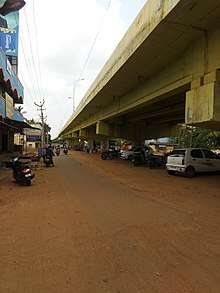
Buses that connect the nearby villages and smaller towns (e.g. Devakottai,Kalayarkoil, Thirupathur, Illayankudi, Thiruvadanai) terminate at the Sivagangai bus-stand. The State Transport Corporation runs long-distance buses to Coimbatore, Chennai from Sivagangai bus-stand. Also main nearest transport hubs are Mattuthavani Bus Terminus & Arappalayam Bus Terminus Madurai, So connecting to Madurai city 24Hrs bus services available from Sivagangai Bus stand. From Sivagangai all mofussil buses that connect towns such as Karaikudi, Manamadurai, Trichy, Sivakasi, Aruppukottai, Dindigul, Oddanchatram, Palani, Pattukottai, Thanjavur, Theni, Erode, Aranthangi, Nagore, Thiruvarur, Velankanni, Rameshwaram, Ramanathapuram, Kalayar Kovil, Paramakudi, Dharapuram, Pudukottai, Nagapattinam, Tiruppur, Coimbatore(TNSTC), terminate at the bus-stand. And 24 Hrs buses available to reach Madurai[Mattuthavani Integrated Bus Terminus].
National Highway 85 Cochin-Munnar-Bodinayakanur-Theni-Madurai City-Sivagangai-Thondi, NH 36 Villupuram- Panruti-Kumbakonam - Thanjavur-Pudukottai-Tirupathur-Sivagangai-Manamadurai and State Highway SH 34 Ramanathapuram-Ilayankudi-Sivagangai-Melur are the major roads passing via Sivaganga.
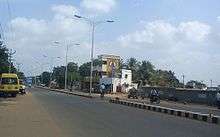
Train
. Sivaganga railway station is located in the east side of town, where the railway line of Trichy-Rameshwaram join and this is serving as Guard line for Virudhunagar to Tiruchirapalli Jn for southern districts trains to reach Chennai Egmore and also operating for goods service due to reduce the rush in main line ( Virudhunagar, Madurai Jn, Dindigul, Tiruchy ).[38] Several Express trains and passenger trains are passing through the town and connecting with the cities like Karaikudi, Rameshwaram, Ramanathapuram, Tiruchirapalli, Coimbatore, Erode, Tiruppur, Chennai Egmore, Thanjavur, Viluppuram, Cuddalore, Pudukottai, Virudhachalam, Varanasi, Bhuvaneswar, etc. So There are direct trains from Madurai connecting the important cities in Tamil Nadu like Chennai, Coimbatore, Kanyakumari, Trichy, Tirunelveli, Karaikudi, Mayiladuthurai, Rameswaram, Thanjavur and Virudhachalam. Madurai has rail connectivity with important cities and towns in India.
Air
Nearest airport is Madurai International Airport 40 km away from the city. There from connectivity available to Major cities like Chennai, Delhi, Mumbai, Hyderabad, Bangalore also with abroad like Dubai, Singapore, and Colombo.
Education
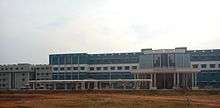
Government Sivagangai Medical College and Hospital is an Educational Institution located in outskirts of Sivagangai Municipality, Tamil Nadu.Also in city having several colleges like Mannar Durai singam Government Arts and Science college, Government girls arts and science college, Vickram Engineering college, Pandian Saraswathi Yadav Engineering College, Micheal Engineering college, Pannai engineering college. Prist University (Madurai Cambus) also located 15 km away from city.
Economy
Graphite is one of the common resources in Sivagangai.[39] Very valuable graphite is available in Sivagangai and its surrounding areas.The Sivaganga graphite is of flaky variety with 14% average Fixed Carbon used in the manufacture of refractory bricks, expanded graphite, crucibles and carbon brushes. TAMIN has over 600 acres of graphite bearing land in Pudupatti, Kumaripatti and Senthiudayanathapuram of Sivaganga taluk, Sivagangai District, Tamil Nadu. Estimated reserve of graphite ore in leasehold area is three million tonnes.(recoverable graphite from 14% F.C is approximately 3 lakh tonnes).[40]
The majority of the workforce is dependent on agriculture (72.8%). The principal crop of Sivaganga district is paddy rice. Most of the district has red soil. The other crops grown are sugarcane, groundnuts, pulses, millet and cereals. Tamil Nadu Agricultural University plans to set up the State's first Red Soil Dryland Research Centre in Sivaganga district.
Sakthi sugar factory is also located in Padamathur, Sivaganga. It has the capacity to produce more than 5000 tons of sugar per day. It provides employment to more than 1000 labourers, directly and indirectly. Moser Baer Clean Energy Limited has commissioned a 5 MW grid connected solar PV project at Sivaganga, Tamil Nadu. The project was awarded to Sapphire Industrial Infrastructure Pvt. Ltd., a wholly owned subsidiary of MBCEL, through a competitive bidding process conducted by the Tamil Nadu Renewable Development Agency. The project is implemented under the 50 MWp generation based incentive scheme of the Ministry of New and Renewable Energy, Government of India.[41]
Tourism
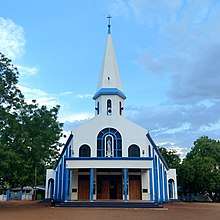
Sivagangai also having some major attractive tourism places nearby town area. Sakkanthi Big Chettinad style home is famous for cinema shouting and cultural attractives. Alangara Annai Cathedral is the major church and headquarters for Roman Catholic Diocese of Sivagangai. ( Including Ramnad and Sivagangai District ). The church is more attractive architecture style which seems like "Fish structure" from the bird eye view. Very famous Kannudayal Nayagi Amman temple, in Nataraasan kottai which is 5 km away from the town. Eswar temple in Kalayarkoil is the one of the major Hindu temple and pandiyan architecture construction. This temple tower is highest in sivagangai district.
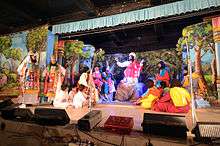
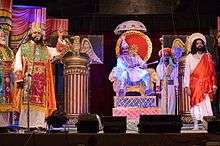
Thiru irudhaya Aandavar Church (திருஇருதய ஆண்டவர் தேவாலயம்) is very famous among in Christian community. Every first Friday in month huge prayer meetings and functions are conducting in this church. Which is located in Idaikattor away from 12 km from the town. Thayamangalam amman temple is another major attractive devotional places for Hindu people.
Utility services
Electricity supply to Sivaganga is regulated and distributed by the Tamil Nadu Electricity Board (TNEB). The town along with its suburbs forms the Madurai Electricity Distribution Circle.[42] Water supply is provided by the municipality of Sivaganga from Idaikathur Vaigai river (2.5 MLD) and Paiyur Pillai vayal & Keelpathi (0.4 MLD) through feeders located in various parts of the town. In the period 2010–2011, a total of 2.9 million litres of water was supplied every day for households in the town.[43] About 22.5 metric tonnes of solid waste are collected from Sivaganga every day by door-to-door collection and subsequently the source segregation and dumping is carried out by the sanitary department of the municipality. The coverage of solid waste management had an efficiency of 90% as of 2001.[44] There is no underground drainage system in the town and the major sewerage system for disposal of sullage is through septic tanks, open drains and public conveniences.[45] The municipality maintains a total of 79.57 km (49.44 mi) of storm water drains: 38.75 km (24.08 mi) surfaced drains and 40.82 km (25.36 mi) kutcha drains.[46] There is a government hospital, a government women and children hospital, and 21 private hospitals and clinics that take care of the health care needs of the citizens.[47] There are a total of 2,013 street lamps in Sivaganga: 333 sodium lamps, 1,662 tube lights, 17 mercury vapour lamps and five high mast beam lamp.[48] The municipality operates two markets, namely a daily market and a weekly market that cater to the needs of the town and the rural areas around it.[49]
Notable people
- Palaniappan Chidambaram
- Kaniyan Pungundranar
- Seeman
- Ganja Karuppu
- Tha. Kiruttinan
- Perarasu
- Chinnaponnu
- Kannadasan
See also
References
- Sivagangai Municipality, Commissioner. "Sivagangai Municipal Council". Department Of Municipal Administration And Water Supply.
- Iyer 1899, pp. i-ii
- Iyer 1899, pp. iii-iv
- Sivagangai Municipality, Commissioner. "Sivagangai Municipal Council". Department Of Municipal Administration And Water Supply. Retrieved 31 December 2012.
- "Weather statistics for Sivaganga". yr.no. Retrieved 4 January 2015.
- "Census Info 2011 Final population totals". Office of The Registrar General and Census Commissioner, Ministry of Home Affairs, Government of India. 2013. Retrieved 26 January 2014.
- "Census Info 2011 Final population totals - Sivaganga". Office of The Registrar General and Census Commissioner, Ministry of Home Affairs, Government of India. 2013. Retrieved 26 January 2014.
- Sivagangai Municipality, Commissioner. "Sivagangai Population details". Sivaganga Municipality. Retrieved 31 December 2012.
- "Population By Religious Community - Tamil Nadu" (XLS). Office of The Registrar General and Census Commissioner, Ministry of Home Affairs, Government of India. 2011. Retrieved 13 September 2015.
- MSME 2012, p. 3
- "Sivaganga district court". District Courts. 2013. Retrieved 1 January 2014.
- "Chairman of Sivaganga". Sivaganga Municipality, Government of Tamil Nadu. 2012. Retrieved 1 January 2014.
- "Commissioner of Sivaganga". Sivaganga Municipality, Government of Tamil Nadu. 2012. Retrieved 1 January 2014.
- "Vice Chairman of Sivaganga". Sivaganga Municipality, Government of Tamil Nadu. 2012. Retrieved 1 January 2014.
- "MLA of Sivaganga". Government of Tamil Nadu. 2012. Retrieved 1 January 2014.
- "Seventeenth Loksabha, Member of the Parliament". Parliament of India. 2019. Retrieved 28 September 2019.
- "About Sivaganga Municipality". Sivaganga Municipality. Retrieved 1 January 2014.
- "Commissionerate of Municipal Administration". Commissionerate of Municipal Administration. Archived from the original on 6 November 2012. Retrieved 1 January 2014.
- Economic and political weekly 1995, p. 2396
- "Budget 2010–11" (PDF) (in Tamil). Sivaganga Municipality. Retrieved 1 January 2014.
- "List of Assembly Constituencies". Tamil Nadu. Tamil Nadu state government. 2010. Archived from the original on 14 June 2012. Retrieved 1 January 2014.
- "Map showing the new assembly constituencies" (PDF). Election Commission of India. p. 1. Retrieved 1 January 2014.
- "Partywise Comparison Since 1977". Election Commission of India. 2011. Retrieved 1 January 2014.
- "Key highlights of the general elections 1980 to the Seventh Lok Sabha" (PDF). Election Commission of India. p. 79. Retrieved 29 December 2012.
- "Key highlights of the general elections 1984 to the Eighth Lok Sabha" (PDF). Election Commission of India. p. 73. Retrieved 29 December 2012.
- "Key highlights of the general elections 1989 to the Ninth Lok Sabha" (PDF). Election Commission of India. p. 81. Retrieved 29 December 2012.
- "Key highlights of the general elections 1991 to the Tenth Lok Sabha" (PDF). Election Commission of India. p. 51. Retrieved 29 December 2012.
- "Key highlights of the general elections 1999 to the Thirteenth Lok Sabha" (PDF). Election Commission of India. p. 85. Retrieved 29 December 2012.
- "Key highlights of the general elections 2004 to the Fourteenth Lok Sabha" (PDF). Election Commission of India. p. 94. Retrieved 29 December 2012.
- "Key highlights of the general elections 1977 to the Sixth Lok Sabha" (PDF). Election Commission of India. p. 80. Retrieved 29 December 2012.
- "Key highlights of the general elections 1996 to the Eleventh Lok Sabha" (PDF). Election Commission of India. p. 86. Retrieved 29 December 2012.
- "Key highlights of the general elections 1998 to the Twelfth Lok Sabha" (PDF). Election Commission of India. p. 85. Retrieved 29 December 2012.
- "Key highlights of the general elections 1967 to the Fourth Lok Sabha" (PDF). Election Commission of India. p. 67. Retrieved 29 December 2012.
- "Key highlights of the general elections 1971 to the Fifth Lok Sabha" (PDF). Election Commission of India. p. 71. Retrieved 29 December 2012.
- V., Mayilvaganam; TNN (17 May 2014). "Election results 2014: As P Chidambaram power fails Karti comes fourth". The Times of India. Retrieved 17 May 2014.
- Archived 10 April 2010 at the Wayback Machine
- Tamil Nadu Minerals Limited (2006). "Graphite". Tamil Nadu Minerals Limited. Archived from the original on 1 February 2011.
- "Brief Industrial Profile of Sivagangai" (PDF). Department of Industry, Ministry of Small scale industries, Government of India. 26 May 2014.
- Moserbaer Projects Private Limited (2010). "Moser Baer Projects Private Limited — Divisions — Solar Power — Projects". Moserbaer Projects Private Limited.
- "Important Address" (PDF). Indian Wind Power Association. 2011. p. 3. Archived from the original (PDF) on 16 October 2012. Retrieved 1 January 2014.
- "Water Supply Details". Sivaganga Municipality. 2011. Retrieved 1 January 2014.
- "Waste management programme". Sivaganga Municipality. 2011. Retrieved 1 January 2014.
- "Water Sewage Details". Sivaganga Municipality. 2011. Retrieved 1 January 2014.
- "Storm water drains of Sivaganga". Sivaganga municipality. 2011. Retrieved 1 January 2014.
- "Sivaganga hospitals". Sivaganga municipality, Government of Tamil Nadu. 2011. Retrieved 1 January 2014.
- "Street lights of Sivaganga". Sivaganga municipality. 2011. Retrieved 1 January 2014.
- "Sivaganga Markets". Sivaganga Municipality, Government of Tamil Nadu. 2011. Retrieved 1 January 2014.
Other sources
- Iyer, K. Annasawmi (1899). The Sivaganga Zemindary: Its Origin and Its Litigation 1730 to 1899, with a Genealogical Tree. Hoe & Company, Printers.
- MSME Development Institute. Brief Industrial profile of Sivaganga district (PDF) (Report). Chennai: Ministry of MSME, Government of India.
| Wikimedia Commons has media related to Sivaganga. |